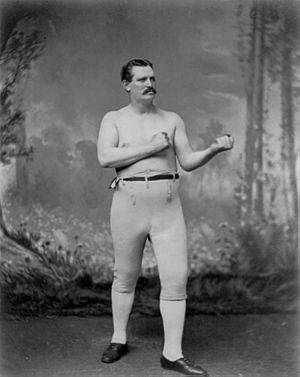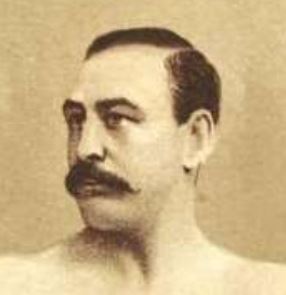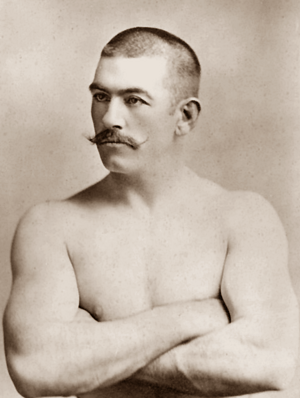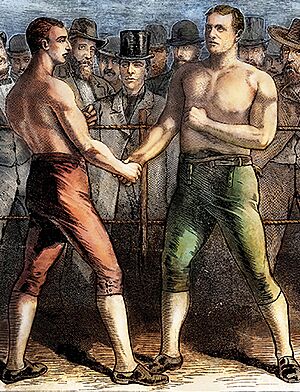Paddy Ryan facts for kids
Quick facts for kids Paddy Ryan |
|
|---|---|

Paddy Ryan, 1887
|
|
| Statistics | |
| Real name | Patrick Ryan |
| Nickname(s) | The Trojan Giant |
| Rated at | Heavyweight |
| Height | 5 ft 11 in (1.80 m) |
| Nationality | Settled in America as a youth |
| Born | 15 March 1851 Settled in Troy, NY. by 1872 Lived in San Francisco, 1886-8 |
| Died | 14 December 1900 (aged 49) Green Island, New York, near Troy |
| Stance | Orthodox (right-handed) Used London Prize Ring Rules 1877-86 |
| Boxing record | |
| Total fights | 10 Major fights only Exhibitions excluded |
| Wins | 2 |
| Wins by KO | 1 |
| Losses | 7 |
| Draws | 3 |
Patrick Ryan (born March 15, 1851 – died December 14, 1900) was an Irish American boxer. He became the American heavyweight champion in bare-knuckle boxing on May 30, 1880. He won this title from Joe Goss. Ryan held the championship until February 7, 1882, when he lost it to the famous John L. Sullivan.
Ryan had only ten major boxing matches. However, he also took part in about twenty-five exhibition fights. These exhibitions, especially with Sullivan later on, helped him earn money. They involved fewer rounds and were less risky than official fights.
Contents
Early Life and Boxing Start
Ryan was born in Thurles, Tipperary, Ireland, on March 14, 1851. After moving to America, he lived in the Troy, New York area. This is how he got his nickname, "The Trojan Giant."
Before becoming a boxer, Ryan might have worked as a blacksmith. He definitely worked in that job when he lived in Troy. As a strong young man, he also helped build the Erie Canal. In 1874, Ryan opened a saloon in Troy. There, he caught the eye of Jim Killoran, an athletic director. Killoran saw Ryan handling difficult situations at the saloon. He decided to train Ryan as a professional fighter.
Ryan's first match was in 1877. In his early career, he was a mix of a fighter, grappler, and wrestler. The boxing rules at the time, called the London Prize Ring Rules, allowed some wrestling moves. Some boxing experts think he was better at wrestling than boxing. They believe he could have used more special boxing training.
Becoming American Heavyweight Champion in 1880
The former heavyweight champion, Jem Mace, had not fought for many years. People believed he had given up his title, leaving it open for a new champion. The fight against Joe Goss was Ryan's first official prize fight. However, he had fought before to settle arguments, sometimes against other boxers.
Ryan fought Joe Goss for the bare-knuckle heavyweight championship. This important fight happened on May 30, 1880, in Collier's Station, West Virginia. The Mayor of Pittsburgh had said the fight was illegal in his city. So, the fighters moved to a more hidden spot in West Virginia.
Ryan won the fight in the 87th round. Goss could not continue, and the match stopped after 90 minutes. Ryan's last punch was a right hand that knocked Goss out. The fight was close and well-fought until then. Goss's team claimed a foul in the 87th round. Since he could not go on, the judges gave the win to Ryan. Ryan was very bruised on his face and body. Ryan was also almost twenty pounds heavier and six inches taller than Goss. This big size difference would not be allowed in boxing today. It might have helped Ryan win the match.
Exhibition Fights in 1881
In 1881, Ryan took part in eight exhibition matches. Most of these were in the New York area. He fought Joe Goss again on May 18. Then, he faced John Dwyer on July 2. Later, on October 1, he fought Captain James Dalton, a well-known local opponent.
Losing the American Heavyweight Title in 1882
John L. Sullivan and Ryan arrived in New Orleans on February 6, 1882. They were there to decide who would be the American heavyweight champion. The governor of Louisiana said the fight was illegal. So, Sullivan, Ryan, and their groups moved the fight to Mississippi.
The next day, the crowd moved to Mississippi City, Mississippi. A boxing ring was set up in front of the Barnes Hotel. The local sheriff was not there, so the fight happened in Mississippi. At that time, Mississippi did not have a written law against boxing.
Sullivan, who was proud of his Irish heritage, wore green shorts and socks. Ryan wore white shorts and socks with special spiked boxing shoes. This was a bare-knuckle fight, meaning no gloves were used. It followed the London Prize Ring Rules and took place on dirt in a 24-foot ring. This might have been Sullivan's first bare-knuckle fight.
Each side put up $2,500, plus an extra $1,000. Richard K. Fox, who owned a boxing magazine, supported Ryan. James Keenan from Boston supported Sullivan. This made the winner's prize $3,500, which was a large amount for that time. About 2,000 people watched the fight.
Ryan was six years older than Sullivan. He was also about ten pounds lighter, but an inch or two taller. This gave him a longer reach. However, Sullivan was faster and had better defense. Ryan was also not in as good shape. Sullivan's helpers were Billy Madden and Joe Goss. James Shannon was his umpire. There was a disagreement about choosing a referee. Finally, two referees were chosen: Alexander Brewster and Jack Hardy.
Ryan was 37 years old, which was considered old for a boxer back then. He knew his long career had taken a toll on him. He said, "I meant to have retired before, but you know how it is. When you whip somebody there is always somebody else turning up that wants to try his hand, and that’s the way I am caught this time."
Following an old tradition, Sullivan threw his hat into the ring at 11:45 am. Ryan entered the ring at 11:57 am. The crowd was estimated at 5,000 people. The men then walked to the "scratch line" in the middle of the ring and shook hands.
The New York Herald newspaper reported that Sullivan looked better from the very first round. His right punches were very powerful, and Ryan had trouble recovering. Early in the fight, Sullivan knocked Ryan down with his famous right punch. Ryan quickly fought back and wrestled Sullivan to the ground to end the second round. But this move tired Ryan out. After that, Sullivan easily threw Ryan around when they clinched.
After nine rounds and only twenty minutes, Sullivan knocked Ryan out. His final punch was a right hand under Ryan's left ear. Ryan left the ring with his jaw clearly swollen. This was the last time the heavyweight championship was won in a bare-knuckle fight. Ryan fought Sullivan many times after this, but he never won. After the fight, Sullivan often practiced with Ryan. Sullivan became very famous and was accepted by both rich and poor Americans. This was new in boxing and helped both boxers attract large crowds to their later exhibition fights.
In Ryan's time, boxing titles were not official like they are today. There were no worldwide groups to make titles legitimate. Some people called him the "Heavyweight Champion of America." Others called him a world champion. He was largely seen as the world champion while he held the title. This is because heavyweights were the most important weight class then and had the most fans.
Later Fights and Exhibitions (1883-1897)
Ryan boxed less often in 1883. On October 21, he knocked out Jack Waite in a three-round exhibition. The results of some other fights he planned that year were not reported in the news. He continued to fight few opponents in 1884 and 1885. On January 19, 1885, Ryan had a "no contest" fight with Sullivan at Madison Square Garden in New York. Some sources say Ryan lost, but police stopped the fight in the first round.
On September 13, 1886, Ryan had a two-round draw with Frank Glover in Chicago. Ryan weighed 210 pounds, which was more than his usual fighting weight. A newspaper described him as "fleshy." The referees could not agree on a winner, so it was called a draw. About a dozen police officers stopped the fight in the second round. The match was fought on a boat in the rain, using the London Prize Rules. About 1,500 people watched the match.
New boxing rules, called the Queensbury Rules, banned all wrestling moves. This might have made it harder for Ryan in his next fight against Jack McCaulliffe, who was a better scientific boxer. The Queensbury Rules also had fixed three-minute rounds and longer one-minute rest periods. This helped boxers get their strength back. A ten-second count for a knockdown also gave an injured boxer time to recover. These rules also made boxing safer by banning punches to the back of the head.
Ryan lived in San Francisco for a few years in the late 1880s. On November 13, 1886, Ryan had a non-title rematch with Sullivan. This was at the Mechanic's Pavilion in San Francisco, California. About 8,000 people watched. Ryan lost by knockout in a three-round fight. He was knocked down in the first round. Ryan was knocked down again in the second round. A second knockdown in the third round ended the fight. This fight used gloves and followed the new Queensbury Rules.
Ryan lost to Joe McAuliffe, who knocked him out in three rounds on December 23, 1887, in San Francisco. This fight used gloves and the new Queensbury Rules. McCauliffe was thirteen years younger than Ryan. He was known as a strong and powerful puncher. Ryan was knocked down twice in the first round. In the second round, McCauliffe hesitated to hit a groggy Ryan. At the start of the fourth round, Ryan's helpers gave up, ending the match.
Several newspapers reported that Ryan lost to John Donner on May 4, 1888, in Duluth, Minnesota. However, a reliable source said that the boxer was not Paddy Ryan, the former champion. This source said Ryan was living in San Francisco at the time.
From 1891 to 1897, Ryan performed in many popular exhibition fights with Sullivan. Most of these were in New England. After these, he retired from boxing. In a three-round exhibition in March 1896, Sullivan was described as "beefy" and not looking like a boxer. Ryan, however, was said to still be in good shape.
On March 5, 1899, Ryan worked as a referee for the Alt Allen vs. Fred Wyatt match in Plattsburgh, New York.
Death
After retiring from boxing, Ryan returned to New York. He refereed a few fights and worked in Albany.
In his last months, Ryan had trouble speaking. He also suffered from a kidney disease called Bright's disease. People started collecting money to help him. Sullivan gave a lot of money to this fund. A special event was also held in his honor at Madison Square Garden.
Ryan died from his illness on December 14, 1900, in Green Island, New York. He was 49 years old. He was buried in St. Mary's Cemetery. He was survived by his daughter.
In 1973, Ryan was chosen for The Ring magazine's Hall of Fame.
Selected Fights
| 1 Win, 4 Losses, 1 Draw | |||||||
| Result | Opponent(s) | Date | Location | Duration | Notes | ||
| Win | Joe Goss | 30 May 1880 | Collier's Station, West Virginia | 87 Rounds | Won Heavyweight Championship of America | ||
| Loss | John L. Sullivan | 7 February 1882 | Mississippi City, Mississippi | 9 Rounds | Lost Heavyweight Championship of America | ||
| Loss | John L. Sullivan | 19 January 1885 | New York, New York | 1 Round | Police stopped the fight | ||
| Draw | Frank Glover | 13 September 1886 | Chicago, Illinois | 2 Round | London Rules; Police stopped the fight | ||
| Loss | John L. Sullivan | 13 November 1886 | San Francisco, California | 3 Rounds | Was knocked out | ||
| Loss | Joe McCauliffe | 23 December 1887 | San Francisco, California | Queensbury Rules; 3 Rounds | Was knocked out | ||
| Loss | John P. Donner | 4 May 1888 | San Francisco, California | 3 Rounds | Was knocked out | ||
Images for kids





